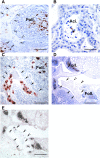Prions in milk from ewes incubating natural scrapie
- PMID: 19079578
- PMCID: PMC2587713
- DOI: 10.1371/journal.ppat.1000238
Prions in milk from ewes incubating natural scrapie
Abstract
Since prion infectivity had never been reported in milk, dairy products originating from transmissible spongiform encephalopathy (TSE)-affected ruminant flocks currently enter unrestricted into the animal and human food chain. However, a recently published study brought the first evidence of the presence of prions in mammary secretions from scrapie-affected ewes. Here we report the detection of consistent levels of infectivity in colostrum and milk from sheep incubating natural scrapie, several months prior to clinical onset. Additionally, abnormal PrP was detected, by immunohistochemistry and PET blot, in lacteal ducts and mammary acini. This PrP(Sc) accumulation was detected only in ewes harbouring mammary ectopic lymphoid follicles that developed consequent to Maedi lentivirus infection. However, bioassay revealed that prion infectivity was present in milk and colostrum, not only from ewes with such lympho-proliferative chronic mastitis, but also from those displaying lesion-free mammary glands. In milk and colostrum, infectivity could be recovered in the cellular, cream, and casein-whey fractions. In our samples, using a Tg 338 mouse model, the highest per ml infectious titre measured was found to be equivalent to that contained in 6 microg of a posterior brain stem from a terminally scrapie-affected ewe. These findings indicate that both colostrum and milk from small ruminants incubating TSE could contribute to the animal TSE transmission process, either directly or through the presence of milk-derived material in animal feedstuffs. It also raises some concern with regard to the risk to humans of TSE exposure associated with milk products from ovine and other TSE-susceptible dairy species.
Conflict of interest statement
The authors have declared that no competing interests exist.
Figures



References
-
- Prusiner SB. Novel proteinaceous infectious particles cause scrapie. Science. 1982;216:136–144. - PubMed
-
- McKinley MP, Bolton DC, Prusiner SB. A protease-resistant protein is a structural component of the scrapie prion. Cell. 1983;35:57–62. - PubMed
-
- Lasmezas CI, Deslys JP, Robain O, Jaegly A, Beringue V, et al. Transmission of the BSE agent to mice in the absence of detectable abnormal prion protein. Science. 1997;275:402–405. - PubMed
-
- Collinge J, Sidle KC, Meads J, Ironside J, Hill AF. Molecular analysis of prion strain variation and the aetiology of ‘new variant’ CJD. Nature. 1996;383:685–690. - PubMed
Publication types
MeSH terms
Substances
LinkOut - more resources
Full Text Sources
Other Literature Sources
Research Materials
Miscellaneous

